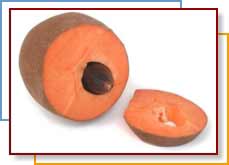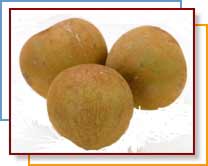Home | FOOD ARTICLES | Food Trivia | Today_in_Food_History | Food_History_Timeline | Recipes | Cooking_Tips | Food_Videos | Food_Quotes | Who’s_Who | Culinary_Schools_&_Tours | Food_Trivia_Quizzes | Food_Poems | Free_Magazines | Food_Festivals_and_Events
Food Articles, News & Features Section
FREE Magazines
and other Publications
Free Professional and Technical Research, White Papers, Case Studies, Magazines, and eBooks
SAPOTE
Sapote is quite rare in the United States. Only a few acres in Florida and California are planted with this fruit. Sapote has a orange flesh that is unusually soft, juicy, creamy and has a sweet, mild flavor that hints at flavors such as coconut, vanilla, and lemon. Sapotes are the size of a grapefruit or orange and are bright green or brown in color. This fruit is a native of the highlands of Mexico, but has grown in California since the early 1800s. Varieties such as the mamey, black skinned, green skinned, yellow skinned and about half a dozen more uncommon varieties pop up in grocery stores and farmer’s markets from time to time.
Selection, Storage, and Preparation
Sapotes are generally on the market in fall and winter, but seasonality can vary from year to year. Select hard fruits and store at room temperature. However, they last only about 3 days. Chill briefly before serving. This fruit can be frozen as well; wrap the whole fruit and tuck into the freezer. To serve, half thaw in the refrigerator, and then scoop the rest out like sherbet.

Make Sapotes part of your 5 to 9 A Day Plan!
--White sapotes can be eaten like a ripe persimmon.
--Spoon the pulp from the skin and enjoy it plain or with a few drops of added lemon or lime juice.
--Add cut-up sapote to a common fruit salad for a new taste and flavor. 
Serving Size: ½ fruit (113g)
Amount Per Serving % Daily Value
Calories 150
Calories from Fat 5
Total Fat 0.5g 1%
Saturated Fat 0g 0%
Cholesterol 0mg 0%
Sodium 10mg 0%
Total Carbohydrate 38g 13%
Dietary Fiber 3g 12%
Sugars --g
Protein 2g
Vitamin A 10%
Vitamin C 35%
Calcium 4%
Iron 6%
* Percent Daily Values are based on a 2,000 calorie diet.
RELATED ARTICLES
Please feel free to link to any pages of FoodReference.com from your website.
For permission to use any of this content please E-mail: james@foodreference.com
All contents are copyright © 1990 - 2025 James T. Ehler and www.FoodReference.com unless otherwise noted. All rights reserved.
You may copy and use portions of this website for non-commercial, personal use only.
Any other use of these materials without prior written authorization is not very nice and violates the copyright.
Please take the time to request permission.
